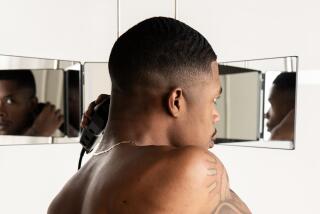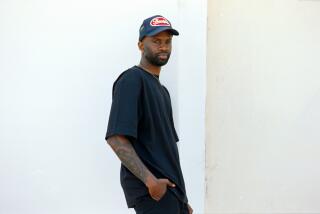Take a little off the top: How visits to the barbershop helped reduce blood pressure in African American men
- Share via
When a customer opens the well-worn door to Eric Muhammad’s barbershop in Inglewood, he’ll be looking to relax in the comfort and camaraderie of a neighborhood meeting place and maybe to take a little off the top or sides.
If that visitor is among the close to 40% of African American men with high blood pressure, he might also get a little taken off the top of that vital health reading.
For the record:
6:00 p.m. March 14, 2018A previous version of this story incorrectly identified the two pharmacists who participated in this study as a black man and a white woman.
New research suggests that shops like Muhammad’s A New You Barber and Beauty Salon might be just the place to rescue African American men from an epidemic that has ravaged their ranks: uncontrolled hypertension.
The study found that when a group of African American men with untreated high blood pressure got a screening and a friendly nudge from their barber, as well as a visit to the shop from a pharmacist, close to two-thirds of the men brought their blood pressure into a healthy range.
Their systolic blood pressure — the top-line number that measures the pressure in your vessels when the heart beats — fell by an average of 27 points. In addition, their diastolic blood pressure — the bottom number that measures pressure on the vessels’ walls between heart beats — fell by an average of nearly 15 points.
The 132 men who got a barbershop visit from a pharmacist were almost six times more likely to bring their blood pressure under control than were those who just got a barber’s advice to eat better, exercise more and see a doctor. Fewer than 12% of the 171 men in the latter group brought their blood pressure under control. (Their average reductions in systolic and diastolic blood pressure readings were too small to be considered statistically significant.)
The clinical trial was conducted from February 2015 to July 2017 in 52 black-owned barber shops across Los Angeles County. Two pharmacists specially trained to treat high blood pressure shuttled across a 450-square-mile area bringing advice and an array of medications to the study’s participants.
“Bringing rigorous medicine directly to men in a barbershop, and making it so convenient for them, really made a difference,” said Dr. Ronald G. Victor, who led the new study.
“We had hoped for maybe a seven-point difference” between the two groups in their systolic blood pressure, the one that is considered a better predictor of heart attack and stroke risk, Victor said. “But this was a really big difference” — the kind that “could make an impact on a national level” if the initiative were scaled up, he said. “We were really ecstatic.”
The trial results were published in the New England Journal of Medicine and presented Monday at the American College of Cardiology’s annual meeting.
Victor said that the inclusion of two pharmacists — a white woman and a woman of color, each of whom turned in similar results — was the “secret special sauce” that appeared to bring participants’ blood pressure in check.
But skilled as these pharmacists were, Victor said they might not have gained the trust and influence they eventually enjoyed if they had not been welcomed into barbershops and introduced by their trusted proprietors.
“I can’t emphasize enough how much the barbers’ buy-in made all the difference,” said Victor, the associate director of Cedars-Sinai’s Smidt Heart Institute. The African American shop owners who participated in the study had been in business an average of 17 to 18 years, and the men they enrolled had typically been coming to their shops for more than a decade, typically once every two weeks.
Muhammad was among the first to sign on to the study. The proprietor of his shop for 18 years, Muhammad helped recruit nearly half of the other barbers who participated in the trial.
At the busy corner of La Brea and Florence avenues, Muhammad presides over a “refuge” whose door is open “whether you’re a doctor or a gang member.” For a lot of people, he said, “just being here is a blessing.”
Muhammad said he has always considered himself a potential agent of health promotion. But “it certainly surprised me for a doctor to come up with that idea,” he said.
Victor said that his own hypertension had been diagnosed by a barber during a training session for an earlier version of this study in Texas. When Victor protested that he must have been momentarily tense while getting tested, the barber gently admonished him.
“If you can’t relax in my barber chair, Doc, you’ve got a problem,” the stylist told him. “Now if you’re gonna talk the talk, you gotta walk the walk.”
Close to 40% of African American men have high blood pressure, a higher rate than any other ethnic group. And about one-third of those men — compared with 43% of white men and almost 50% of black women — have brought their hypertension under control with medication.
This exacts a breathtaking toll among African American men in terms of death and disability. Their high rates of heart attack and stroke largely explain the 3.4-year difference in the life expectancy between blacks and whites in the United States.
Victor was optimistic that barbershops could help close that gap.
“These are magical places,” he said. “They’re a window into some of the most positive aspects of black men’s social lives: loyalty, friendship, inclusiveness. There are dads bringing their sons in, customers who have come to the same place since they were children. These men were not in the clinic, that’s for sure.”
In African American communities, “we can map the places of black barbers right there alongside black ministers” as agents of trust and authority, said Vassar College history professor Quincy T. Mills.
Prospective patients might ordinarily view physicians and pharmacists with a suspicion borne of years of systemic abuses, Mills said. But in the familiar environment of their barbershop, “I suspect the men were comforted that these interactions were happening in a crowd of people, giving them space to ask others, to push back.”
Mills, the author of “Cutting Along the Color Line: Black Barbers and Barber Shops in America,” said that a man’s health is not a subject that routinely comes up while he is in the chair. But a barber’s position of leadership, his association with personal care and the connections he forges over time with his customers may allow him to stretch the bounds of what is permissible.
“That level of trust in the barber is the first critical piece here,” he said.
MORE IN SCIENCE
DIY or die: How an Australian outback nurse diagnosed his own heart attack and saved his life
This is ‘nanowood,’ a new invention that could greatly reduce humanity’s carbon footprint
On Twitter, fake news spreads faster and further than real news — and bots aren’t to blame







